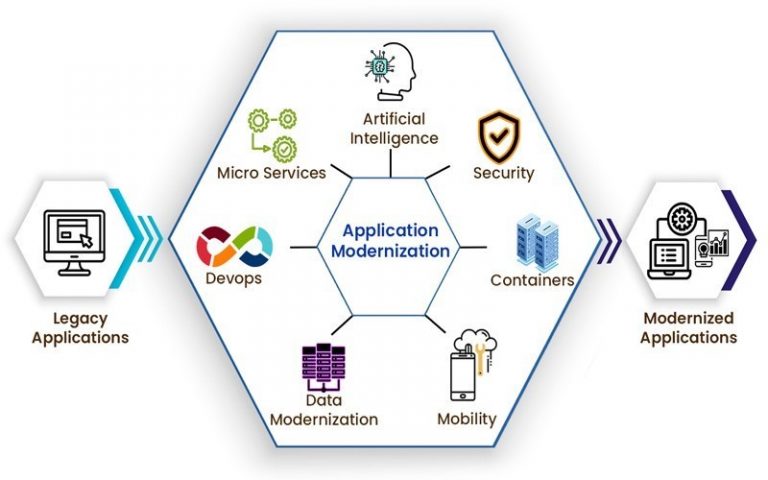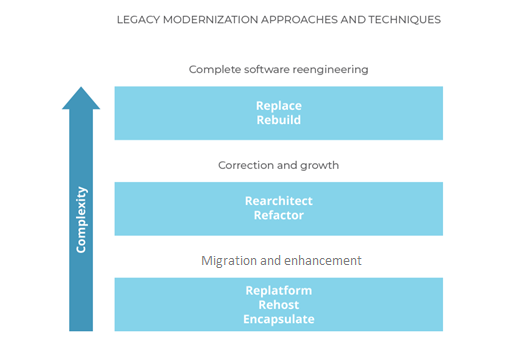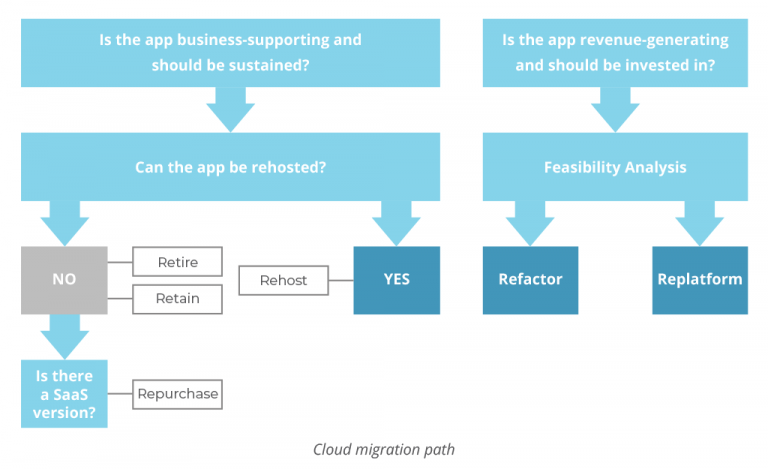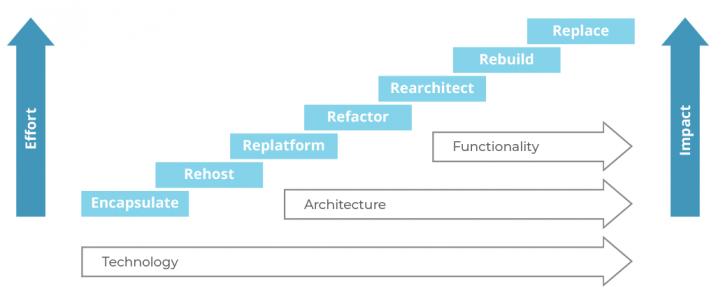Practitioner’s take on application modernization – Challenges and approach
Written by: Faisal Tajammul, GM at Systems APAC
March 26, 2021
With advancements in underlying hardware and infrastructure that runs these applications, legacy applications are becoming increasingly redundant and hard to maintain. These redundancies gradually affect user experience, organizational productivity, and overall business operations. As a result, the business suffers, and the whole purpose of employing technology is lost. A very crude example is your new computer runs Windows 10 instead of Windows XP. Obviously, your current computer is more powerful and more capable than the one you owned 10 years ago. Similarly, the business you run is not the same as it was when you started it.
As a solution, legacy application modernization and migration involve modernizing and upgrading the company’s age-old systems. The main goal of the legacy application modernization process is to add effective value to the existing apps. Application modernization is the constant progress of transforming legacy systems to reduce IT costs and complexity, maintain data consistency, enhance process flexibility and enable cross-platform collaboration. It converts the existing system to a high-level modern web platform and integrates various related systems.

Challenges & risks
A Gartner report published in early 2019 estimates that around 90% of legacy applications would continue to serve critical business needs for many enterprises, with less than 10% moving ahead to modern platforms. The primary reason is that there are a lot of challenges that legacy modernization projects face. This article covers them and indicates the solutions to tackle each of them.
Lack of knowledge/skills
This is the primary challenge in legacy application modernization because:
- Shortage of Developers that understand legacy application technology stack.
- Functional and technical documentation is missing, irrelevant, or not up-to-date,
- Source code is highly patched and developed over years without a proper design document
- Sources of third-party applications/libraries used, are not available.
One possible approach to tackle this is to go through the code manually and identify the functionality, which is a humungous task, especially because a lot of code (usually around 30-40% of the entire code base), is redundant or no longer in use. The best way is a tool-assisted approach which Systems adopts in its modernization initiatives. This tool analyzes the code base, extracts dependencies and identifies unused code, hence the dependency on technical and functional documentation is highly reduced.
Multiple legacy applications
For organizations that have a large footprint of legacy systems, App modernization is a daunting task. App modernization, in this case, is more complex since it needs to be carefully managed. When we attempt to take even a single application for modernization, the upstream and downstream applications still would be in legacy technologies, with a lot of legacy protocols, file formats etc. It is highly risky to take them to the modern platform in one go.
An iterative approach needs to be followed in such cases. We need to take critical ones first and then handle the rest. We may also need to prepare certain tools and design the application to support the legacy ways, such that during the interim, there is no impact on the existing business flow. Once all applications are modernized, support for the legacy footprint could be turned off. This is the approach that we are pursuing in modernizing a large enterprise system for a leading global Reinsurance provider.
Quality assurance
Another challenge is quality assurance, as the legacy application would have been successfully running well, and the modernized application has to be tested in order to confirm that they are functionally equivalent.
As with every IT project, we need to ensure that all possible test scenarios and test cases are well-defined and documented. We have used test-driven development with great success to ensure that automated tests are part of the CI/CD pipeline. In addition to test automation, the user acceptance test has to be planned well, and having as many business users as possible could help ensure the soundness and completeness of the modern application.
Data migration
Most legacy ecosystems would have had a long life until modernization. Hence, they would have a lot of data by means of business transactions. In addition to this, the legacy systems could be using different data types or encoding. This adds another dimension of difficulty in data migration, when not planned well.
In order to take care of differences in encoding, there are tools in the market and also certain ETL plugins that help in migrating the data seamlessly.
Business Impact
During production cut-over, there is usually a longer downtime due to high complexity. When starting the modernization, there could be continuous changes to the legacy source code for bug fixes or enhancements. Also, the UX of the application would have considerably changed, leading to initially reduced productivity of business users.
When the application is modernized in chunks, the downtime could be reduced during a rollover. A code-freeze period should be enforced after baselining. And, once the baseline is modernized, further changes could be incorporated into the target application. Also, when business users are onboarded into the project right from the discovery phase, their buy-in will be ensured, as well as their familiarization with the new UX. Extensive training needs to be planned to ensure that users are ready to work on the new application.
Besides the challenges, there are multiple risks to avoid which are,
- The organization inadvertently adopts a flawed or incomplete reengineering strategy.
- The workforce is tied to old technologies with inadequate training programs.
- The organization does not have its legacy system under control.
- There is too little elicitation and validation of requirements.
- Software architecture is not a primary reengineering consideration.
- Management lacks long-term commitment.
- Management predetermines technical decisions.
Approaches to Legacy System Modernization
Below are three modernization approaches to help you pick the one that can deal best with your current legacy challenges. As we move from one to another, the complexity increases so as the effort.
Platform modernization & Enhancements:
This is one of the most popular approaches to application modernization and the quickest to achieve with the least complexity. It assumes the system migration (typically re-hosting, using cloud solutions) and some minor enhancements. This includes UI/UX updates, performance optimization, and database migration. The Limitation of this method is that the core business logic and architecture mostly remain unchanged.
Architecture optimizations:
If the product technology stack is relatively modern and does not represent a threat to future product growth, modernization can involve some minor enhancements/corrections. This might be architecture optimization or code refactoring, UX updates or performance optimization without significant changes in product business logic. As soon as the product is updated, you can add more features on top of it. These might be third-party integrations or custom-built modules.
Complete software reengineering:
Considered the most extreme approach, feature extraction relies on your business strategy and growth outlook. This means, that in order to reengineer the product, you need to identify the features that are still crucial to your business and the ones that are no longer used or required. After that, the required features are prioritized and modified if needed. Taking the legacy system as a basis, the team creates an up-to-date product with matching capabilities, but better performance, look and feel, modern technologies and scalable architecture.

Encapsulation is a technique for reusing legacy software components. While leaving the code in its current environment, encapsulation connects it to the new presentation and accesses layers via an API. That helps leverage the application and extend its features and value. However, encapsulation will not solve problems already present, such as difficulties with maintenance and upgrading, since its main concern is the interface and not the internals of the legacy system.
Rehosting means moving a mainframe application unchanged to other physical, virtual, or cloud infrastructure. This technique is of the lowest cost and risk. While re-engineering projects can take years, rehosting is faster and keeps the underlying business logic intact meaning zero negative impact on the enterprise. As a result, the system operates in exactly the same way. With the rehosting technique, an application is forklifted to the cloud as is, without any code modification. While offering a less resource-intensive migration process, rehosting doesn’t generally make use of cloud-native features as do re-platforming and refactoring techniques.
Replatform migrations include a bit of up-versioning to adjust the code to a new platform while preserving existing functionality. The minimal changes like using a managed database offering or adding auto-scaling, a feature that automatically adds or removes compute resources, can help return the basic profit of cloud infrastructure. And that’s perfectly fine because not all applications need the full benefits of being cloud-native.
Code refactoring presupposes restructuring and optimizing existing code without changing its external behaviour. Refactoring an application component allows for solving technical problems and improving the component’s features and structure. By re-coding some portion of an existing application organizations are able to take full advantage of cloud-native features and maximize operational cost efficiency in the cloud.

Rearchitecting means shifting to a new application architecture while altering the code to fully exploit the new and better capabilities of the platform. This technique has medium cost and risk, but also medium results.
Rebuilding (Redesign) rewrites the application components from scratch while preserving their scope and specifications. At the same time, redesigning your application opens the door to new features, functionality, and processes that leverage the capabilities of modern technology and third-party platforms.
Replacing. Sometimes it is better to entirely replace the app with a different tool rather than invest in its modernization. While the reuse of existing legacy business logic is not possible in this case, some level of reengineering or customization of packages and rewriting business logic may be involved in this process.

Conclusion
Legacy modernization frees your business from performance & scalability issues and enables you to append essential business functionality quickly. Remember these best practices while trying to carry out legacy modernization:
- Give a serious look at cloud-based solutions
- Make Portability a Priority
- Rethink the architecture & prioritize simplicity
- Take an evolutionary approach towards modernization
- Deconstruct the application into different building blocks & components
- Document everything for future growth
The tried and tested model explained here can certainly help make the right decisions. Systems Limited’s Application Modernization methodology offers a wide set of tools and approaches to get the maximum benefits of Application Modernization initiatives.
Quick Link
You may like
How can we help you?
Are you ready to push boundaries and explore new frontiers of innovation?


